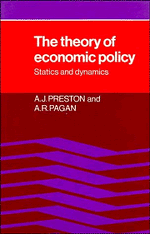Book contents
- Frontmatter
- Contents
- Preface
- Part I The static theory of policy
- Part II Dynamic fixed objectives: on hitting points and paths
- Part III Dynamic flexible objectives: on tracking points and paths
- 11 Dynamic finite horizon flexible objective problems
- 12 Policy existence and uniqueness for infinite horizon flexible objective problems
- 13 Some stability issues in dynamic policy problems
- 14 Aftersight
- References
- Index
11 - Dynamic finite horizon flexible objective problems
Published online by Cambridge University Press: 05 November 2011
- Frontmatter
- Contents
- Preface
- Part I The static theory of policy
- Part II Dynamic fixed objectives: on hitting points and paths
- Part III Dynamic flexible objectives: on tracking points and paths
- 11 Dynamic finite horizon flexible objective problems
- 12 Policy existence and uniqueness for infinite horizon flexible objective problems
- 13 Some stability issues in dynamic policy problems
- 14 Aftersight
- References
- Index
Summary
Rationales for the dynamic flexible objective problem
The previous four chapters have provided an account of policy existence, uniqueness and design representing the dynamic counterpart of the static problem considered in Chapter 2. Thus it is appropriate that a failure of global path controllability (of global existence) be resolved in an analogous manner to a corresponding failure of existence for static fixed objectives – by the stipulation of a quadratic objective function centred on the desired, but unattainable, fixed objective path followed by the minimisation of this function subject to the linear policy model constraint. Such an approach logically parallels Chapter 3 and provides a motivation for ‘linear/ quadratic control’ stressing its role as a design method for selecting from amongst the set of ‘second-best’ policies those which compromise the unattainable objective in a preferred way.
Although the above rationale for a linear/quadratic analysis is an attractive one it is not unique. In a dynamic context a policymaker may be able to attain a fixed target path with a certain degree of anticipation but may be unwilling to vary policy with the requisite lead, his impatience leading to a willingness to trade-off exact attainment for immediate action. Alternatively, global path controllability might prevail but should either implicit instrument constraints be violated or instrument instability be manifested by the appropriate policy path of Theorem 9.6, the policymaker may again decide to trade-off exact attainment of his target path against non-violation of the magnitude or stability constraints on his instruments.
Information
- Type
- Chapter
- Information
- The Theory of Economic PolicyStatics and Dynamics, pp. 313 - 331Publisher: Cambridge University PressPrint publication year: 1982
